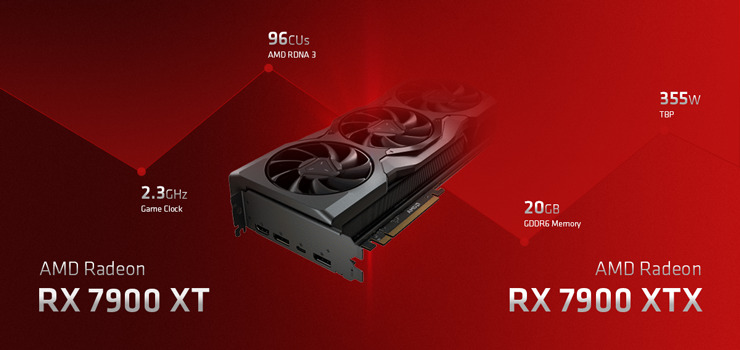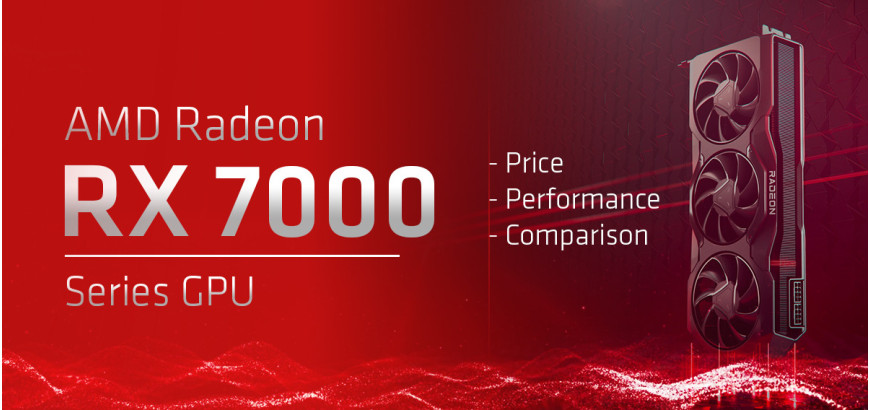AMD CEO Lisa Su takes the stage on November 3 with their answer to the Nvidia RTX 4000 Series Graphics Cards. Radeon’s New RX 7000 Series GPU launch and unveiling of the RDNA3 details bring hope to the gaming community. After Nvidia’s premium pricing for the RTX 4000 GPUs, AMD aims to take on the market with a sub-one thousand dollar price tag. RX 7000 family arrives in the retail stores on December 13th, featuring the brand new RDNA3 microarchitecture.
At the launch, the AMD boss disclosed two top-tier models. Featured with the latest RDNA3, the RX 7900 XT & XTX graphics cards hit the shelves at 899$ & 999$. Out of all other robust features like the FSR 2.0 and support for Display Port 2.1, we loved the rigorous promise of the 8K gameplay possibility. Here’s our take on the new RX 7000 Series.
RDNA3 Architecture of RX 7000 Series
RX 7000 Series Graphics Cards take inspiration from AMD Ryzen microarchitecture. Unlike the previous generation cards such as the 5700 XT or 6800 XT, this time the RDNA3-based RX 7000 GPUs comprise a chiplet design.
AMD did not go for a super-ultra-tech-brand-new process to shrink down everything in a single die as Nvidia did with the 4nm monolithic RTX 4000 Series. Unlike previous RDNA2 cards, the RDNA3 RX 7000 blueprint takes inspiration from AMD’s Ryzen and Epyc processors. Instead of one single die, the GPU is built with a chiplet form at TSMC. This chiplet integrates several individual processors to work together, in a single unit. The RDNA3 RX7000 GPU comprises two processing segments. A 5nm Graphics Compute Die (GDC) and a total of six 6nm Memory Cache Die (MCD).
This also gives the RDNA3 RX 7900 cards a beefy advantage of keeping their crown for power efficiency. Which significantly reduces the production cost for vendors like Gigabyte, MSI, Asus, etc. Consequently, you won't break four fingers buying an RX 7900 graphics card.
Together the six Cache Dies deliver a whopping 2.7x data feeding the 5 nm Graphics Dies, putting next to the last generation RDNA2. Engineers at AMD had to huddle for the RDNA3 graphics card’s chiplet design. It allows 5.3 TB/s interconnect for all of the dies to communicate quickly enough. With this, the GDC reportedly is 1.5 times faster in raytracing, claimed by AMD.

Specifications of RX 7900 Series Graphics Cards
Both of the new RX 7900 Graphics Cards offer downright gaming capacity. With a vast array of features ready to give blazing frame rates, the RX 7900 XTX offers extra compute units than the RX 7900 XT. Also, the clock speed bumps up 200MHz for an additional 55W power draw. The number of cores this time is 6144 for the 7900 XTX and 5376 for the XT variant.
Graphic processing doesn’t just stop there. We said the Radeon’s AMD 7000 Series Graphics Card is packed with promises. And here’s the chart for what AMD has to offer us. See for yourself when we bring these RX 7000 Series graphics cards to Bangladesh. Till then, let us munch on the numbers AMD gave us.
| Graphics Card | RX 7900 XT | RX 7900 XTX |
|---|---|---|
| Compute Units | 84 | 96 |
| Infinity Cache | 80 MB | 96 MB |
| Frequency | 2000 MHz | 2300 MHz |
| VRAM | 20 GB | 24 GB |
| Memory | GDDR6 | GDDR6 |
| TBP | 300 W | 355 W |
Comparison: RX 7000 Vs RX 6000 Series
As per AMD, 4K gameplay will get a “HUGE” upscale with the RX 7900 XTX compared to the previous top tier 6950 XT. We can not drop these claims completely because obviously with that many compute units (CU) on the PCB, the cards should give “something” close to the proportional performance. So what’s the add-on?
From Lisa Su, AMD 7000 Series Graphics Cards are giving 54% more efficiency in overall performance than the previous generation Radeon GPUs. In all cases, we want to go head to head with the last generation’s most advanced cards and the top contestant of the native competitor, Nvidia RTX 4090 which hit the stores a few weeks ago.
RX 7000 Series: Components
Two of the Radeon RX 7000 series vanguard the ‘NAVI 31’ based RDNA3 lineup. At the top tier are the RX 7900 XTX and a slightly reduced cache-sized RX 7900 XT. Where the XTX takes on 6 separate MCDs, the XT variant comprises 5 of them.
In total, an unbelievable 58 billion transistors lay throughout the AMD Radeon GPU this time. That sums to about 165% more transistors/mm2 area. This unprecedented number of micro transistors in semiconductor engineering is an art, to speak the truth. We can surely say, RDNA3 lands to push the graphics technology to the next era of computing supremacy.
Next-Gen Ray Tracing of RDNA361 Tera FLOP Compute Units put in the RX 7900 GPUs are about to burst ray tracing capacity like never before. RDNA3 comes with 2nd Generation Ray Tracing Accelerators for 50% more instructions per CU. From mere shadow and ambiance management of 23 TFLOPs in RDNA2, ray tracing is going to get real this time. Enjoy more real-life volumetric weather effects & microdetails rendering in shadow and light based on physics.
Incredible Power Management With Decoupled Clock Speed
AMD Decoupled the clock speed this time for Compute Units. Keeping the front-end clock static at 2.5 GHz max, the shader units set back at 2.3 GHz, reducing as much as 25% energy loss in the RX 7000 graphics cards.
Next, performance per watt. we’d love to appreciate AMD’s claims, though a 55%+ PPW boost is very vague. Where the Nvidia RTX 4090 has a 450 W rating, the Radeon RX 7900 has 355W at the top. That is a solid 95W difference. And this translates that long-time ownership costs will reduce dramatically.
Add the flexibility of power connector ports - where AMD Radeon RX 7900 cards both take the traditional 2x8 pin connectors. The Nvidia 4000 uses a single 16-pin 12VHPWR power port. Surely, you can add ports to the modular PSU, but with a non-modular PSU, the job becomes painstaking.
Size of Radeon 7000 Series GPU
The RX 7900 XTX & XT cards fit in your motherboard taking only 2 and a half slot space. In contrast, Nvidia RTX 4090 is taking much more of your casing space owing to the 3.5 slot form factor. Gamers upgrading from year old GPU might consider this because technically upgrading a casing with a motherboard or CPU for PCIe full 16 lanes implies you do not have the same computer anymore. Or, do you?
Features of Radeon RX 7000 Graphics Cards
Radiance Display Engine in the RX 7000 GPU features the first Display Port 2.1 support in the industry. Nvidia's current generation cards work with the 1.4 DP technology. However, AMD surely has surpassed everyone else in display capability here. With a 54GB/s display link bandwidth, the radiance engine combines up to 68 Billion colors with a 12-bit per channel color recognition.
AV1 Encoding is an AMD-developed new audio-video encoder that is specially built for heavy streaming and recording jobs. Dual Media Engine, a new enhancement from the AMD Radeon team for accelerated AV1 Encoding & Decoding simultaneously. Doubling the engine frequency, this piece of tech will boost media output up to 1.8x from previous times.
The cards will generate 8K resolution at an unprecedented 165Hz on 8K or up to 480 Hz for 4K, on high-end monitors like Samsung Odyssey Curved ones. This means the AMD 7000 Radeon GPUs are a good investment considering 8K Gaming Monitors and TVs at Star Tech are coming in fast as we notice in Q4, 22.
FSR, Team Red’s champion for AI-powered framerate downsampler and upscaling technology, the Fidelity FX Super Resolution. Now running the 2.1 version, FSR will go head-on collision with NVIDIA’s DLSS 3.0 technology. DLSS 3 is still maturing, FSR 2 on the other hand seems the mightier boy in reducing ghosting as of 2022.
Above all, we have to wait till 2023 to see how they work in more than 215 games that support the technology. AAA Games like Cyberpunk, Halo Infinite, Callisto Protocol, Apex Legends, Valorant, and Overwatch 2 experience beyond 600 fps at 1440p resolution. If AMD still fails to baffle you with these numbers, we might as well wait till Q2 & Q3 of the upcoming year. Want more? FSR 3 is on the way in 2023 with Fluid Motion Technology.
To sum up, by December 13th we might have the most advanced Gaming Graphics Card
featuring -
- Easy GPU upgradation with the most Performance Per Watt
- Display Ports 2.1 support with AMD’s AV1 encode-decode technology
- High Refresh Gaming up to 8K @ 165Hz
- 24GB VRAM for max workloads
We hope you enjoyed the read and are ready for the RX 7000 Series GPUs to avail from Star Tech upon release. Keep an eye on our website and retail centers all across Bangladesh for online purchases, or pre-orders if you are an early bird!



Comments
There are no comments for this Article.